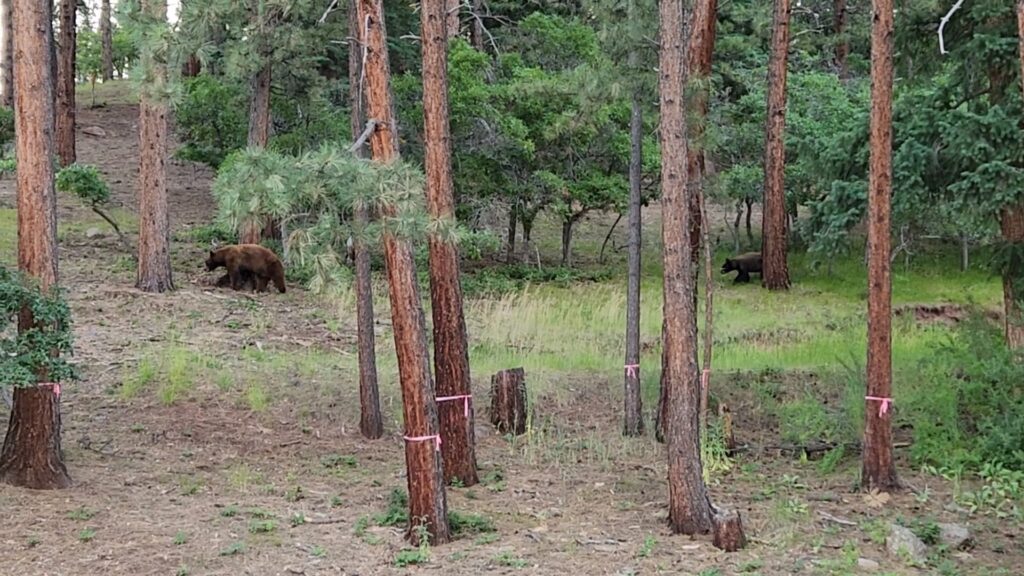Upper Brazos Property Owners' Association

Wildlife Safety
We owe it to ourselves and our neighbors to ensure we are enjoying wildlife in the Brazos with the utmost respect.
Wildlife Safety in the Upper Brazos
Hello Neighbors!
One of the things we all love about the Brazos Canyon is the wildlife that call the Brazos home. We owe it to ourselves and our neighbors to ensure we are enjoying the wildlife with respect. Our actions are having a direct impact on the increase of wild animals in our neighborhood this year, we are seeing bears that are seemingly unafraid of people climbing on porches and going through trash people have left outside. I know we all love seeing the deer out our windows but we have to remember the deer are also prey for mountain loins and we are seeing more of them in the canyon than in years past. Just this morning, we had a confirmed sighting of a mountain lion on Tall Pine near the Aspen Grove.
We must all do our part to protect ourselves and our neighbors to avoid dangerous encounters with these animals. Please take some time to review the safety tips below.
We will continue to share important updates as needed, including in our upcoming newsletter. Be sure to join the In the Brazos and the Upper Brazos Property Owners Association Facebook groups for the current information on life here in the Brazos.
As always, the board members are happy to answer any questions you may have at info@upperbrazospoa.org.
Stay safe!
Your UBPOA Board
Teri Fahs, Alicia Eiler, John Holtry, Karen Adam, Meredith Pond
Bear Safety
Here are Six At-Home BearWise Basics
- Never Feed or Approach Bears – Intentionally feeding bears or allowing them to find anything that smells or tastes like food teaches bears to approach homes and people looking for more. Bears will defend themselves if a person gets too close, so don’t risk your safety and theirs!
- Secure Food, Garbage and Recycling – Food and food odors attract bears, so don’t reward them with easily available food, liquids or garbage
- Remove Bird Feeders When Bears Are Active – Birdseed and grains have lots of calories, so they’re very attractive to bears. Removing feeders is the best way to avoid creating conflicts with bears.
- Never Leave Pet Food Outdoors – Feed pets indoors when possible. If you must feed pets outside, feed in single portions and remove food and bowls after feeding. Store pet food where bears can’t see or smell it.
- Clean & Store Grills – Clean grills after each use and make sure that all grease, fat and food particles are removed. Store clean grills and smokers in a secure area that keeps bears out.
- Alert Neighbors to Bear Activity – See bears in the area or evidence of bear activity? Tell your neighbors and share information on how to avoid bear conflicts. Bears have adapted to living near people; now it’s up to us to adapt to living near bears.
You can find more information on Bear Safety at www.BearWise.org
Mountain Lion Safety
Mountain lions are solitary animals, traveling alone except during mating season or when a female is supporting young. They can be seen at any time of the day or night, but are most active at dawn and dusk, corresponding with deer activity.
Mountain lions are carnivores (meat eaters) and prey mostly on deer. They also eat small animals like porcupines, rabbits, squirrels, marmots, and skunks.
Here are some guidelines to stay safe when in the Brazos:
- Do not jog or hike alone. Go in groups with adults supervising children.
- Keep pets on a leash. Do not leave pets outside overnight.
- Keep children close to you. Do not allow children to play along river banks, in heavy vegetation, or alone at dawn or dusk. When hiking with children, watch them closely and never let them run ahead of you. Observations of captured wild mountain lions reveal that the animals seem especially drawn to children.
If you encounter a lion, remember the goals are to convince it that you are not prey and that you may be dangerous. Follow these safety tips:
- Do not approach a lion. Most mountain lions will try to avoid a confrontation. Give them a way to escape.
- Do not run from a lion. Running may stimulate a mountain lion’s instinct to chase. Instead, stand and face the animal. Make eye contact. If you have small children with you, pick them up if possible so that they don’t panic and run. Although it may be awkward, pick them up without bending over or turning away from the mountain lion.
- Do not crouch down or bend over. A human standing up is just not the right shape for a lion’s prey. Conversely, a person squatting or bending over resembles a four-legged prey animal. In mountain lion country, avoid squatting, crouching or bending over, even when picking up children.
- Do all you can to appear larger. Raise your arms. Open your jacket if you are wearing one. Again, pick up small children. Throw stones, branches, or whatever you can reach without crouching or turning your back. Wave your arms slowly and speak firmly in a loud voice. The idea is to convince the mountain lion that you are not prey and that you may be a danger to it.
- Fight back if attacked. A hiker in southern California used a rock to fend off a mountain lion that was attacking his son. Others have fought back successfully with sticks, caps, jackets, garden tools and their bare hands. Since a mountain lion usually tries to bite the head or neck, try to remain standing and face the attacking animal.
You can find more information on mountain lion safety at www.fws.gov/story/mountain-lion-safety
Upper Brazos Property Owner’s Association
PO Box 633
Tierra Amarilla, NM 87575
info@upperbrazospoa.org
© 2025 Upper Brazos Property Owner's Association. All Rights Reserved.